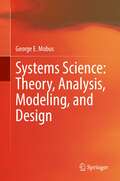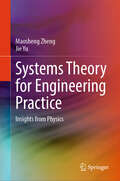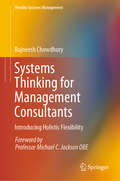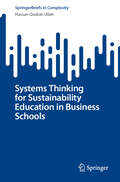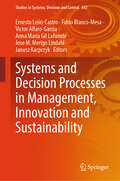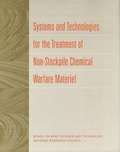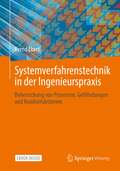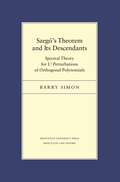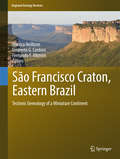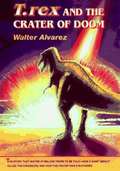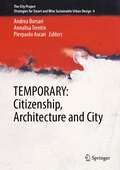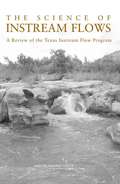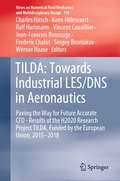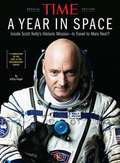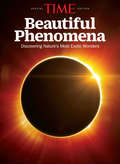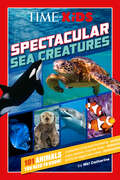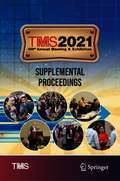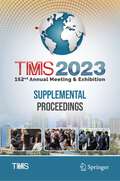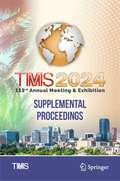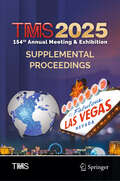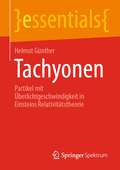- Table View
- List View
Systems Science: Theory, Analysis, Modeling, and Design
by George E. MobusThis book describes a comprehensive approach to applying systems science formally to the deep analysis of a wide variety of complex systems. Detailed ‘how-to’ examples of the three phases (analysis-modeling-design) of systems science are applied to systems of various types (machines, organic (e.g. ecosystem), and supra-organic (e.g. business organizations and government). The complexity of the global system has reached proportions that seriously challenge our abilities to understand the consequences of our use of technology, modification of natural ecosystems, or even how to govern ourselves. For this reason, complex mathematics is eschewed when simpler structures will suffice, allowing the widest possible audience to apply and benefit from the available tools and concepts of systems science in their own work. The book shows, in detail, how to functionally and structurally deconstruct complex systems using a fundamental language of systems. It shows how to capture the discovered details in a structured knowledge base from which abstract models can be derived for simulation. The knowledge base is also shown to be a basis for generating system design specifications for human-built artifacts, or policy recommendations/policy mechanisms for socio-economic-ecological systems management. The book builds on principles and methods found in the authors’ textbook Principles of Systems Science (co-authored with Michael Kalton), but without prerequisites. It will appeal to a broad audience that deals with complex systems every day, from design engineers to economic and ecological systems managers and policymakers.
Systems Theory for Engineering Practice: Insights from Physics
by Jie Yu Maosheng ZhengThis book presents cognition of the universality of systems theory thinking by using some ordinary physical phenomena and their methods in study, of which the involved treatments are consistent with the viewpoint of systems theory. It contains the collective actions of classical vibration of many bodies and wave, the extreme value problem in natural world, status of electrons in atom-molecule and metals, Ising model in phase transition and elementary excitation in solid, multi-objective optimization in a system, description of effective media approximation, certainty in uncertain phenomena, all these reflect the cooperative/synergetic effects, wholeness of group actions, “unity of opposites” inside a system, and collective phenomena in a system completely. The relevant methodologies for systems theory are organic combination and synergism of both “reductionism” and “holism” instead of “confrontation” or “separation” of them, which could be used in dealing with analogous problems in systems science and engineering fields in response to the idiom of “stones from other hills being good for polishing this jade” and “comprehend by analogy”, so as to promote the transformation of wisdom to productivity. The authors wish this work could play its role as a paving stone to serve the research and application of systems theory. This book can be used as a textbook for postgraduate and advanced undergraduate students in relevant majors, and a reference book for scientists and practitioners in related fields.
Systems Thinking for Geoengineering Policy: How to reduce the threat of dangerous climate change by embracing uncertainty and failure (The Earthscan Science in Society Series)
by Robert ChrisEven by the scientists most closely associated with it, geoengineering - the deliberate intervention in the climate at global scale to mitigate the effects of climate change - is perceived to be risky. For all its potential benefits, there are robust differences of opinion over the wisdom of such an intervention. Systems Thinking for Geoengineering Policy is the first book to theorise geoengineering in terms of complex adaptive systems theory and to argue for the theoretical imperative of adaptive management as the default methodology for an effective low risk means of confronting the inescapable uncertainty and surprise that characterise potential climate futures. The book illustrates how a shift from the conventional Enlightenment paradigm of linear reductionist thinking, in favour of systems thinking, would promote policies that are robust against the widest range of plausible futures rather than optimal only for the most likely, and also unlock the policy paralysis caused by making long term predictions of policy outcomes a prior condition for policy formulation. It also offers some systems driven reflections on a global governance network for geoengineering. This book is a valuable resource for all those with an interest in climate change policy, geoengineering, and CAS theory, including academics, under- and postgraduate students and policymakers.
Systems Thinking for Management Consultants: Introducing Holistic Flexibility (Flexible Systems Management)
by Rajneesh ChowdhuryThis book discusses how systems thinking and approaches can aid management consultants in navigating the complexities of client advisory in current realities. It thereby brings to the forefront aspects of holism, flexibility and responsibility - the keys to success in today’s world. Management consultants are called in to offer an independent expert view of an organisation/ a situation and are expected to address some of the most pressing problems businesses face. The client does not exist in a silo, but in a complex environment that lies at the intersection of a range of internal and external factors that are often unseen and unpredictable. The organisation itself presents an alien territory that the consultant is expected to acclimatise to within a very short period of time, and come up with solutions that “insiders” would not have been able to visualise. The book presents a range of ideas, concepts and reference cases that are relevant and topical for consultants in their daily work. It argues that systems thinking allows holism and flexibility in management consulting – while holism is about the ability to encompass the environmental and organisational complexity, flexibility is about the ability to think creatively and adopt different approaches to accommodate this complexity. With commentaries, case studies, conceptual models and perspectives that cut across multiple industries, sectors and countries, this book is a valuable resource for academics and professionals alike. The book’s inner pages and its page on Springer.com contain additional comments providing perspectives of clients, industry experts and academia.
Systems Thinking for Sustainability Education in Business Schools (SpringerBriefs in Complexity)
by Hassan Qudrat-UllahThis book delves into the current state and future prospects of systems thinking and sustainability education within business schools. It meticulously examines the trends and drivers shaping the demand and supply of such education, along with the implications and challenges it presents for various stakeholders and society at large. Strategic recommendations and suggestions are provided to elevate and propel systems thinking and sustainability education in business schools, outlining a visionary roadmap for the future. Furthermore, the book explores the intersectionality of sustainability and diversity in business education, offering examples and cases of visionary and innovative initiatives and projects in the field. Distinguished by special features such as illustrations, the book offers a comprehensive and integrative overview of the current landscape and future trajectories of systems thinking and sustainability education in business schools. The primary benefit for readers lies in gaining a deeper and broader understanding of systems thinking and sustainability education in business schools. It equips them with the knowledge to apply systems thinking and sustainability principles and tools to tackle the complex and wicked problems of the twenty-first century. Additionally, the book aims to inspire and inform business schools and their stakeholders to embrace and enhance systems thinking and sustainability education in their curricula and pedagogy, contributing to the advancement of sustainability and systems thinking in both business and society.
Systems and Decision Processes in Management, Innovation and Sustainability (Studies in Systems, Decision and Control #562)
by Janusz Kacprzyk Ernesto León-Castro Fabio Blanco-Mesa Victor Alfaro-Garcia Anna Maria Gil Lafuente Jose M. Merigo LindahlThe book presents a series of papers with different methodologies that allow us to visualize how the systems support decision-making in areas such as the tourism sector, entrepreneurship, quality of work life, gender, motivation, circular economy, innovation, law, finance, and bibliometrics. The book also finds a series of cases applied in different countries, where through the information collected and the data analyzed, new improvement processes can be generated at the business level and the local, regional, and national levels within Ibero-America. The book presents new methods and systems to create better decision-making processes in the changing and uncertain environments in which people, companies, and governments interact.
Systems and Technologies for the Treatment of Non-Stockpile Chemical Warfare Materiel
by National Research CouncilThe main approach adopted by the U. S. Army for destruction of all declared chemical weapon materiel (CWM) is incineration. There has been considerable public opposition to this approach, however, and the Army is developing a mix of fixed site and mobile treatment technologies to dispose of non-stockpile CWM. To assist in this effort, the Army requested NRC to review and evaluate these technologies, and to assess its plans for obtaining regulatory approval for and to involve the public in decisions about the application of those technologies. This book presents an assessment of non-stockpile treatment options and the application of these systems to the non-stockpile inventory, of regulatory and permitting issues, and of the role of the public.
Systems of Frequency Distributions for Water and Environmental Engineering
by Vijay P. Singh Lan ZhangA multitude of processes in hydrology and environmental engineering are either random or entail random components which are characterized by random variables. These variables are described by frequency distributions. This book provides an overview of different systems of frequency distributions, their properties, and applications to the fields of water resources and environmental engineering. A variety of systems are covered, including the Pearson system, Burr system, and systems commonly applied in economics, such as the D'Addario, Dagum, Stoppa, and Esteban systems. The latter chapters focus on the Singh system and the frequency distributions deduced from Bessel functions, maximum entropy theory, and the transformations of random variables. The final chapter introduces the genetic theory of frequency distributions. Using real-world data, this book provides a valuable reference for researchers, graduate students, and professionals interested in frequency analysis.
Systemverfahrenstechnik in der Ingenieurspraxis: Beherrschung von Prozessen, Gefährdungen und Reinheitskriterien
by Bernd EbertDas Buch behandelt die für das Optimum verfahrenstechnischer Prozesse unerlässliche System-Betrachtung. Diese sollte nicht nur für den „reinen“ Prozess erfolgen, sondern für den gesamten Lebenszyklus technischer Anlagen – vom Entwurf eines Prozesses bis zur Optimierung im laufenden Betrieb. Dabei kommt es nicht nur auf den Normalbetrieb an (wie häufig bei Simulationen betrachtet), sondern auch auf An- und Abfahrprozesse, das Havarie-/Störungsverhalten der Prozesse, die Reinigungsabläufe, Sicherheitsmaßnahmen usw. Geeignete Analyse- und Betrachtungsmethoden werden dazu vorgestellt, die sich in langjähriger Planungs- und Betriebspraxis herausgebildet haben. Hierzu zählen u.a. Risikoanalysen, Zeitdynamik- und Zuverlässigkeitsmethoden; deren theoretischer Ansatz wird mit ihrer praktischen Anwendbarkeit verbunden. Auch Aspekte wie Industrie 4.0 und Prozessänderungen bei laufenden Anlagen werden betrachtet. Damit soll ein Beitrag sowohl für die Ingenieurausbildung, die technische Betriebsbetreuung als auch für die Projektabwicklung geleistet werden.
Szegő's Theorem and Its Descendants: Spectral Theory for L2 Perturbations of Orthogonal Polynomials (Porter Lectures #6)
by Barry SimonThis book presents a comprehensive overview of the sum rule approach to spectral analysis of orthogonal polynomials, which derives from Gábor Szego's classic 1915 theorem and its 1920 extension. Barry Simon emphasizes necessary and sufficient conditions, and provides mathematical background that until now has been available only in journals. Topics include background from the theory of meromorphic functions on hyperelliptic surfaces and the study of covering maps of the Riemann sphere with a finite number of slits removed. This allows for the first book-length treatment of orthogonal polynomials for measures supported on a finite number of intervals on the real line. In addition to the Szego and Killip-Simon theorems for orthogonal polynomials on the unit circle (OPUC) and orthogonal polynomials on the real line (OPRL), Simon covers Toda lattices, the moment problem, and Jacobi operators on the Bethe lattice. Recent work on applications of universality of the CD kernel to obtain detailed asymptotics on the fine structure of the zeros is also included. The book places special emphasis on OPRL, which makes it the essential companion volume to the author's earlier books on OPUC.
São Francisco Craton, Eastern Brazil
by Monica Heilbron Umberto G. Cordani Fernando F. AlkmimThe region of the São Francisco river valley in eastern Brazil encompasses two main components of the geologic framework of the South American continent: the São Francisco craton and its marginal orogenic belts. Cratons, as the oldest, differentiated and relatively stable pieces of the continental lithosphere, preserve a substantial part of the Earth's memory. Orogenic belts, on the other hand, record collisional processes that occurred during a limited time span. Because of their topographic relief, mountain belts developed along craton margins provide however access to rock successions not exposed in the low lands of the adjacent cratons. The combination of geologic information obtained in cratonic domains and their marginal orogenic belts thus form the basis for deciphering substantial periods of Earth's history. Corresponding to the most intensively studied portion of the Precambrian nucleus of the South American plate, the São Francisco craton and its margins host a rock record that spans from the Paleoarchean to the Cenozoic. Precambrian sedimentary successions that witness ancient Earth processes - many of them of global significance - are especially well preserved and exposed in this region. With all these attributes the São Francisco craton together with its fringing orogenic belts can be viewed as a 'Continent within a Continent' or a 'Continent en miniature'.
T. Rex and the Crater of Doom
by Walter AlvarezA geologist describes his research into the extinction of Tyrannosaurus rex and all dinosaurs, caused by a comet or asteroid hitting the Earth.
TBM Design and Construction
by Kui Chen Shengjun Jiao Jiangka WangThis book comprehensively covers the latest technology of TBM's structure and working principle, selection and adaptability design, cutter head design, construction organization and risk control and discusses typical domestic and global case studies on different periods of major TBM projects. Through detailed data and accurate charts, it offers operational guidance with high empirical value. This book is suitable for design, manufacturing, project management, construction and civil and mechanical engineering in the field of TBM technology.
TEMPORARY: Citizenship, Architecture and City (The City Project #4)
by Andrea Borsari Annalisa Trentin Pierpaolo AscariThis book offers a comprehensive overview of forces shaping urban renewal and the sustainable and inclusive transformation of contemporary cities. It discusses temporariness and uncertainty of citizenship, participation, and inclusion, as well as the energy and digital transformation, merging different perspectives, such as the social, philosophical, economic, and architectural ones. Based on revised and extended contributions to the International Congress “TEMPORARY: Citizenship, Architecture and City", held virtually on November 20-21, 2022, from the University of Bologna, this book offers extensive information and a thought-provoking reading to researchers in architecture, anthropology, social and environmental policy, as well as to professionals and policy makers involved in planning the city of the future.
THE SCIENCE OF INSTREAM FLOWS: A Review of the Texas Instream Flow Program
by National Research Council of the National AcademiesAcross the United States, municipalities, counties, and states grapple with issues of ensuring adequate amounts of water in times of high demand and low supply. Instream flow programs aim to balance ecosystem requirements and human uses of water, and try to determine how much water should be in rivers. With its range of river and ecosystem conditions, growing population, and high demands on water, Texas is representative of instream flow challenges across the United States, and its instream flow program may be a model for other jurisdictions. Three state agencies—the Texas Water Development Board (TWDB), the Texas Parks and Wildlife Department (TPWD), and the Texas Commission on Environmental Quality (TCEQ)—asked a committee of the National Research Council (NRC) to review the Programmatic Work Plan (PWP) and Technical Overview Document (TOD) that outline the state’s instream flow initiative. The committee suggested several changes to the proposed plan, such as establishing clearer goals, modifying the flow chart that outlines the necessary steps for conducting an instream flow study, and provide better linkages between individual studies of biology, hydrology and hydraulics, physical processes, and water quality.
TILDA: Paving the Way for Future Accurate CFD - Results of the H2020 Research Project TILDA, Funded by the European Union, 2015 -2018 (Notes on Numerical Fluid Mechanics and Multidisciplinary Design #148)
by Charles Hirsch Werner Haase Vincent Couaillier Koen Hillewaert Ralf Hartmann Jean-Francois Boussuge Frederic Chalot Sergey BosniakovThis book offers detailed insights into new methods for high-fidelity CFD, and their industrially relevant applications in aeronautics. It reports on the H2020 TILDA project, funded by the European Union in 2015-2018. The respective chapters demonstrate the potential of high-order methods for enabling more accurate predictions of non-linear, unsteady flows, ensuring enhanced reliability in CFD predictions. The book highlights industrially relevant findings and representative test cases on the development of high-order methods for unsteady turbulence simulations on unstructured grids; on the development of the LES/DNS methodology by means of multilevel, adaptive, fractal and similar approaches for applications on unstructured grids; and on leveraging existent large-scale HPC networks to facilitate the industrial applications of LES/DNS in daily practice. Furthermore, the book discusses multidisciplinary applications of high-order methods in the area of aero-acoustics. All in all, it offers timely insights into the application and performance of high-order methods for CFD, and an extensive reference guide for researchers, graduate students, and industrial engineers whose work involves CFD and turbulence modeling.
TIME A Year in Space: Inside Scott Kellys Historic Mission Is Travel to Mars Next?
by Jeffrey Kluger The Editors of TIMEGo inside one of the most historic space missions ever in A YEAR IN SPACE, the new special edition from TIME, written by Apollo 13 author Jeffrey Kluger. A YEAR IN SPACE chronicles astronaut Scott Kelly's 340 days aboard the International Space Station (ISS) as part of NASA's exploration of the challenges of extended spaceflight. The most pressing question: Could humans endure the two-and-a-half-year trip to Mars and back?While science has some understanding of how space and zero gravity affect the human body, Scott and his twin brother, Mark, a retired astronaut who remained on Earth, have served as the perfect test and control subjects to explore these effects.This special edition, the companion piece to the TIME and PBS documentary series A Year in Space, provides exclusive coverage coupled with abundant photographs, many taken by Scott Kelly himself.Highlights include:An inside look at how Kelly conducted experiments aboard the ISS and how he spent his downtime.Landscape Mode: Breathtaking photographs taken by Scott Kelly from 250 miles above the Earth's surface.In interview with Samantha Cristoforetti, the first woman to spend 200 days in space, who spoke with TIME about her journey.
TIME Beautiful Phenomena: Discovering Nature's Most Exotic Wonders
by The Editors of TIME MagazineYour guide to the science of eclipses, rainbows, volcanoes, and nature's many wonders.Powerful and dramatic, the natural wonders of our earth dazzled our ancient ancestors-and continue to inspire awe in us today. Now, the Editors of TIME capture these amazing sights and occurrences in an all-new special edition, Beautiful Phenomena, pairing glowing photographs with clear, authoritative text that explains the how, what, why, and when of nature's wonders, including eclipses, rainbows, lightning, supermoons, auroras and so much more. Learn about the scientific breakthroughs that came from observing solar eclipses and other natural phenomena over the centuries . . . and discover the latest theories about them that are emerging today. In space, in the oceans, on the land, these natural wonders hold the keys to our understanding of the world around us. Unlock their mysteries with TIME Beautiful Phenomena.
TIME for Kids: 101 Animals You Need to Know! (TIME for Kids)
by Niki CatherineLearn about sharks, whales, dolphins, jellyfish, sea turtles, and more in this exciting book that features 101 sea creatures!This book is packed with exciting information about 100 of the ocean's most interesting creatures! Get to know seahorses, sea otters, penguins, seals, crabs, sharks, octopuses, whales, dolphins, manatees, and even narwhals in this wonderful book for ocean and animal lovers of all ages.
TMS 2021 150th Annual Meeting & Exhibition Supplemental Proceedings (The Minerals, Metals & Materials Series)
by The Minerals, Metals & Materials SocietyThis collection presents papers from the 150th Annual Meeting & Exhibition of The Minerals, Metals & Materials Society.
TMS 2022 151st Annual Meeting & Exhibition Supplemental Proceedings (The Minerals, Metals & Materials Series)
by The Minerals, Metals & Materials SocietyThis collection presents papers from the 151st Annual Meeting & Exhibition of The Minerals, Metals & Materials Society.
TMS 2023 152nd Annual Meeting & Exhibition Supplemental Proceedings (The Minerals, Metals & Materials Series)
by The Minerals, Metals & Materials SocietyThis collection presents papers from the 152nd Annual Meeting & Exhibition of The Minerals, Metals & Materials Society.
TMS 2024 153rd Annual Meeting & Exhibition Supplemental Proceedings (The Minerals, Metals & Materials Series)
by The Minerals, Metals & Materials SocietyThis collection presents papers from the 153rd Annual Meeting & Exhibition of The Minerals, Metals & Materials Society.
TMS 2025 154th Annual Meeting & Exhibition Supplemental Proceedings (The Minerals, Metals & Materials Series)
by The Minerals, Metals & Materials SocietyThis collection presents papers from the 154th Annual Meeting & Exhibition of The Minerals, Metals & Materials Society.
Tachyonen: Partikel mit Überlichtgeschwindigkeit in Einsteins Relativitätstheorie (essentials)
by Helmut GüntherPartikel, die sich permanent mit Überlichtgeschwindigkeit bewegen, heißen Tachyonen. Die zeitliche Reihenfolge der Endpunkte ihrer Bewegung ist vom Bezugssystem abhängig. Tachyonen können keine Nachricht übertragen, vermitteln aber über beliebig große Entfernungen einen Zusammenhang, ohne dass die Kausalität verletzt wird. Damit besprechen wir das Einstein-Podolsky-Rosen Paradoxon. Ein Teilchen wird durch seine Ruhmasse definiert, ein Tachyon durch einen Impulsparameter. Wir untersuchen Stoßprozesse mit Tachyonen. In Anlehnung an den Begriff des Quasiteilchens betrachten wir über einem Gitter auch Quasitachyonen. Wir erklären die Geschichte mit Schrödingers Katze.
